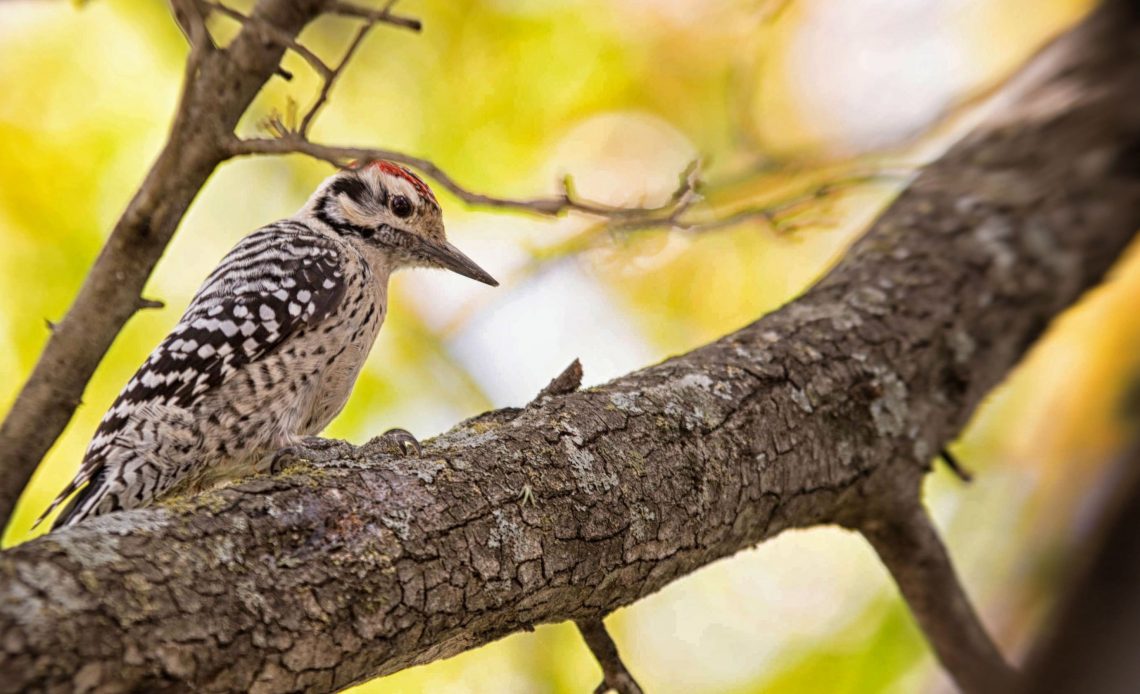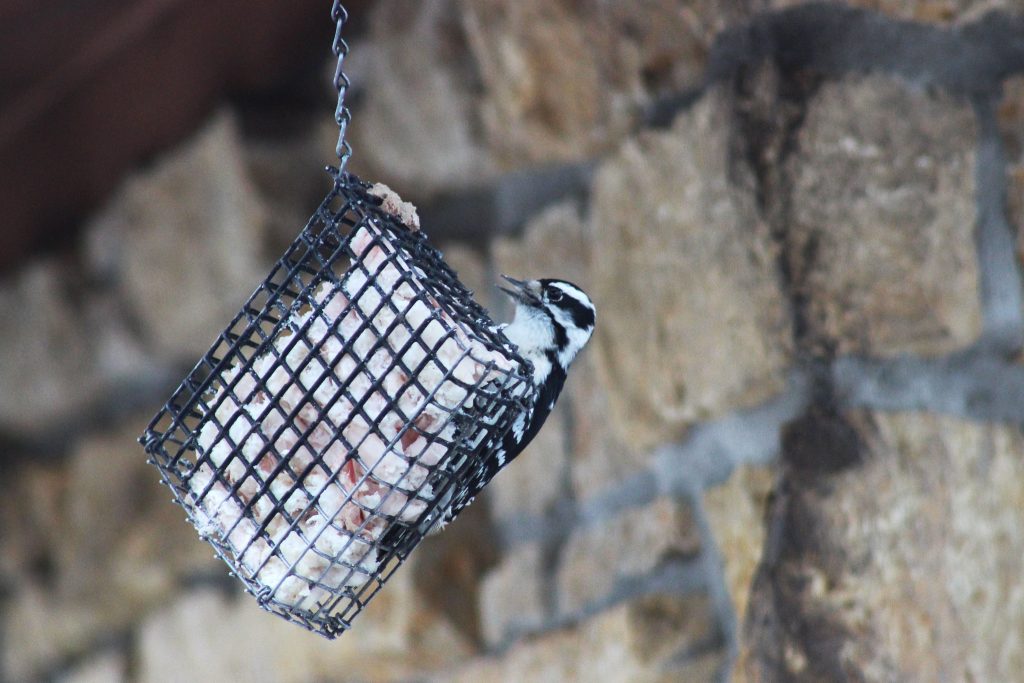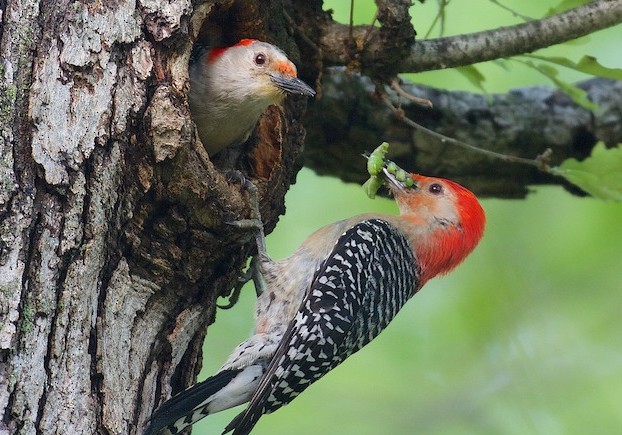

We’re here to help! Wild Yards is a completely free website that is 100% dedicated to helping you create a wildlife-friendly, sustainable yard. Read more
WildYards is reader-supported. When you buy a product through a link on our site, we may earn a comission. Every product is independently selected by our (obsessive) editors and our reviews are unbiased and objective. Read more about our mission or our privacy policy.
Woodpeckers are quite the unique and fun bird to observe.
With close to 20 species of woodpeckers in North America, learning how to attract woodpeckers to your yard is a rewarding and exciting experience for the backyard birder.
Why Should You Attract Woodpeckers to Your Yard?
Woodpeckers are an amazing bird – they’re usually bright-colored, energetic, and full of personality. They also crawl up, down and around trees unlike any other bird. Woodpeckers are fun for the backyard birder to observe.
Woodpeckers are not migratory, which means if your yard happens to catch the eye of a woodpecker, it’s likely you’ll have a feathered companion all year long.
Woodpeckers are also very beneficial to the local ecosystem. Their natural prey are wood boring insects and similar garden pests. Wood boring insects are one of the worst pests you can have – in the worst case scenarios they can cause thousands of dollars of damage to your house and property. Having a first line of defense by attracting woodpeckers is a great natural solution to your pest problem.
A single woodpecker can eat thousands of carpenter ants or wood-boring beetles in a day!
How To Attract Woodpeckers
Woodpeckers aren’t your average bird. They take a little more to attract to your backyard than most birds, but with enough effort, you’re sure to be rewarded with some great views. Attracting woodpeckers is as much work as attracting hummingbirds.
The basics of attracting woodpeckers are the same as with most birds – good source of food, reliable and clean water source, shelter, and nesting opportunities. Woodpeckers are just a little different than most birds and require special attention to their food and nesting situations.
Food: What do Woodpeckers Eat?

Providing a reliable source of food is almost always the easiest way to attract any type of bird to your backyard – including woodpeckers.
In the wild, woodpeckers eat a varied diet which consists largely of insects but also includes nuts, berries, pine seeds and sap. If you’re trying to feed them, they’ll also love to eat black oil sunflower seeds, peanuts, mealworms, suet, suet, and more suet. Did we mention they like suet?
Suet is honestly the easiest and most effective food source to attract woodpeckers. You can even make it yourself with this suet recipe. Once you have some, you can smear it on bark or in specially designed suet bird feeders.
Buying a woodpecker bird feeder is also a great idea. Woodpeckers are shy birds and will stay away from feeders that attract boisterous and loud birds, so it’s a good idea to add a supplementary pecker feeder in a secluded area.
Placing the feeder in an upright position is ideal to mimic their natural eating position.
You should also consider avoiding all pesticides as to not kill off their main source of food – insects.
Talking about gardening. Planting a berry-producing bush or tree is not a bad idea. Shrubs and trees like elderberries, dogwood, mulberry, and other fruit and berry plants are sure to attract woodpeckers.
Water: Create a Private Bath For Woodpeckers
Woodpeckers have to drink and bathe too, but as we mentioned earlier, they’re shy birds. They’re unlikely to visit your bird bath if it’s in an open area and is frequently visited by other birds.
The best thing you can do for woodpeckers is to get a smaller, ground birdbath and place it in a shady and isolated spot. Having a dripper or water pump will make them aware of the water quickly.
But don’t forget, woodpeckers are not migratory so they’ll stick around in the winter and will most likely expect that their source of water stays too. It’s important to have a birdbath heater or de-icer in this case, to allow your woodpeckers access to water even in freezing temperatures.
Shelter: What Trees Do Woodpeckers Like the Most?
Woodpeckers are most comfortable in a heavily wooded environment. So being able to create that feeling by planting some trees or shrubs in a clump or in close proximity is almost a must.
When it comes to what types of trees woodpeckers are attracted to the most, the answer is oak and pine trees. While any mature coniferous or deciduous tree is appealing, the oak and pine kill two birds with one stone (ha). They provide a source of food (acorns and pine seeds) and a place of shelter.
Planting trees or shrubs that both provide shelter and provide a food source is a great way to attract any bird to your backyard. Just make sure it’s a native and local plant for your area.
Nesting Sites: Provide Roosting Options

Unlike most birds, woodpeckers are cavity-nesting species. This means they’ll find or dig out holes in dead trees or branches to nest in.
Of course, they also nest in appropriately sized bird houses made specifically for woodpeckers.
The best ways to encourage a woodpecker to nest in your backyard is to keep a few snags – dead tree branches – and to set up one or two bird houses. You can even build your own woodpecker home!
A dead snag provides a great source of food since wood-boring insects love dead wood and a great place to roost. Just make sure the dead tree or branch won’t cause any damage to your property if it happens to fall.
Adding bird roost boxes to your backyard is a great way to attract woodpeckers. Make sure the entrance hole is the correct size for the woodpecker you want to attract. Hang the bird house 10 – 20 feet in the air in a sheltered area.
Don’t forget to do the usual maintenance for a birdhouse – like cleaning it out after every use and winterizing it when it starts to get cold.
Some Extra Tips and Tricks to Attracting Woodpeckers
Over the years, we’ve gathered a lot of first-hand experience in attracting woodpeckers. We’ve tried different types of bird houses, different types of food sources, many different bird feeders, etc.
Here are a few quick tips and tricks we’ve picked up along the way so you don’t make the same mistakes we did.
- Make sure the suet doesn’t go bad. Rancid suet smells terrible and only attracts unwanted wildlife like raccoons. This is even more important to be careful of in the hot summer months since heat will speed up the rancidness.
- Discourage woodpecker damage. Woodpeckers are amazing birds, until they start causing damage to your house or shed. Learning how to discourage damaging behavior such as drumming is important if you start noticing woodpeckers doing damage.
- Use black oil sunflower seeds. Over the years we’ve noticed that the sunflower seeds are almost always the first seed to disappear from the feeders. Even if it’s a variety seed mix, birds will go out of their way to pick out the sunflower seeds. There’s a reason for that. Black oil sunflower seeds have a ton of meat (nut) on them comparatively and the shell is rather soft so it makes for very easy eating. Woodpeckers also love these sunflower seeds so adding a cake of sunflower seeds to a wire feeder is a great way to attract more woodpeckers.
- Be patient. Attracting a woodpecker is not easy and can take a while. But once you have one visiting regularly you can expect them to come back over and over, all year long.
Do you enjoy watching woodpeckers in your backyard? Do you have any tips or tricks we left out or forgot about? We’d love to hear from you in the comments section below!
